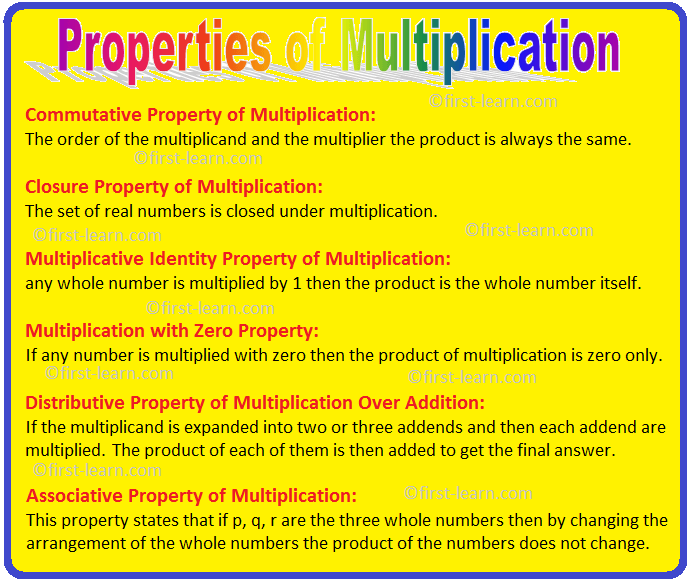Properties of Multiplication
There are few properties of multiplication which makes the calculation of multiplication easier and less time consuming. Moreover, by using the properties of multiplication we can easily find the product of large numbers.
Commutative Property of Multiplication:
This property states that whatever is the order of the multiplicand and the multiplier the product is always the same. That is:
Examples on Commutative Property of Multiplication:
2 × 3 = 3 × 2 = 6
52 × 2 = 2 × 52 = 104
Closure Property of Multiplication:
This property states that if p and q is a whole number then the product of p and q will also be a whole number. This is shown with the help of few examples:
Examples on Closure Property of Multiplication:
7 × 8 = 56
Where 7 and 8 are whole numbers and the product 56 is also a whole number
11 × 5 = 55
Where 11 and 5 are whole numbers and the product 55 is also a whole number
19 × 2 = 38
Where 19 and 2 are whole numbers hence the product 38 is also a whole number
Multiplicative Identity Property of Multiplication:
This property states that if any whole number is multiplied by 1 then the product is the whole number itself. Hence 1 is the multiplicative identity as the value of the whole number does not change.
Examples on Multiplicative Identity Property of Multiplication:
5 × 1 = 5
89 × 1 = 89
150 × 1 = 150
Multiplication with Zero Property:
This property states that if any number is multiplied with zero then the product of multiplication is zero only.
Examples on Multiplication with Zero Property:
0 × 5 = 0
0 × 90 = 0
0 × 560 = 0
Distributive Property of Multiplication Over Addition:
This property states that if the multiplicand is expanded into two or three addends and then each addend are multiplied. The product of each of them is then added to get the final answer.
Examples on Distributive Property of Multiplication Over Addition:
· 6 × 5 = 30
Or, 5 × (3 + 3) = 30
Or, 5 × 3 + 5 × 3 = 15 + 15 =30
· 17 × 3 = 51
Or, 3 × (10 + 7) = 51
Or, 3 × 10 + 3 × 7 = 30 + 21 = 51
· 23 × 6 = 138
Or, 6 × (20 + 3) = 138
Or, 6 × 20 + 6 × 3 = 120 + 18 = 138
In these examples we can see that the product remained unchanged ny applying the associative property of multiplication.
Associative Property of Multiplication:
This property states that if p, q, r are the three whole numbers then by changing the arrangement of the whole numbers the product of the numbers does not change.
Examples on Associative Property of Multiplication:
(i) (5 × 6) × 2 = 5 × (6 × 2)
Þ 30 × 2 = 5 × 12
Þ 60 = 60
(ii) 7 × (3 × 2) = (7 × 3) × 2
Þ 7 × 6 = 21 × 2
Þ 42 = 42
Therefore in both the examples it is seen that by changing the arrangement of the whole numbers their product remained unchanged.
From Properties of Multiplication to HOME PAGE
Recent Articles
-
What Is Plasma? | Blood Plasma | Proteins | Nutrients | Cholesterol
Nov 07, 25 10:29 AM
Blood is a mobile fluid which is a connective tissue and is derived from the mesoderm like cell any other connective tissue. Colour of blood is reddish and that flows inside the blood vessels by means… -
Disorders of Respiratory System | Tuberculosis | Pleurisy | Emphysema
Oct 28, 25 11:39 PM
Tuberculosis is very common disease and is caused by a type of bacteria called Mycobacterium tuberculosis. This disease causes different trouble in the respiration and infection of several parts of th… -
Regulation of Respiration | Respiratory Centres | Inspiratory Area |
Oct 14, 25 12:13 AM
Respiratory Centre is the area that controls the rate of respiration and it is observed to be located in medulla oblongata and pons. Respiratory Centre has the following will dispersed components like… -
Explain Transport of Gases | External Respiration | Tissue Respiration
Oct 09, 25 11:35 PM
In humans gaseous exchange is completed in the following ways the steps are - External Respiration or Breathing - Breathing in false taking in of Oxygen and giving out of carbon dioxide in the body. M… -
Kind and Number of Teeth | Location of Teeth in Mouth | Care of Teeth
Sep 11, 25 12:52 AM
Kind and Number of Teeth






New! Comments
Have your say about what you just read! Leave me a comment in the box below.